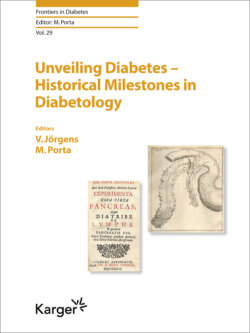Читать книгу Unveiling Diabetes - Historical Milestones in Diabetology - Группа авторов - Страница 26
На сайте Литреса книга снята с продажи.
Understanding Glucose Metabolism
ОглавлениеWhen Claude Bernard started to explore metabolism and diabetes, obscure theories and opinions about metabolism could be found in the textbooks. Magendie had published that animals were unable to synthetize glucose, protein, or fat. Apollinaire Bouchardat believed that diabetes was due to an increased absorption of glucose in the stomach (he changed his mind in later years following the findings of Bernard). Concerning glucose metabolism, in 1844 Mialhé (1807–1886) wrote that glucose was transported by the lymphatic system into the blood and “burned” there. Many assumed that the lungs were the place where this “burning” occurred. Claude encapsulated the level of knowledge in his little red notebook, which is still kept at the Collège de France: “The digestion of carbohydrates takes place in two steps: First: trans-formation of carbohydrates into glucose, second: glucose is burned in the lung. If this doesn’t happen, diabetes occurs.” Claude Bernard asked himself: “Is this true?”
Quoting Claude Bernard’s own words, let us explore the steps leading to his major discovery in August 1848: “To clarify this question, I had to find the sugar in the blood, and to look for the sugar from the vessel of the intestine where it is absorbed to finally the place where it is burned. To study this question I gave sweet milk soup to a dog and sacrificed the dog during digestion. I detected sugar in the vena hepatica. It was logic to conclude that all the glucose that I found in this vein resulted from the sugar the dog had eaten. More than one researcher would have stopped here and would have thought that any control experiment was useless. But I performed a control experiment because I am convinced that in physiology you should always doubt even if the doubt doesn’t seem to be permitted. Therefore, as a control experiment I chose a dog that was exclusively fed with meat. This animal was scarified during digestion and the glucose content of the vena hepatica was examined. I was very astonished noticing that the vena hepatica contained sugar even if the dog hadn’t eaten any carbohydrates.”
Fig. 3. Handwritten by Claude Bernard: “I baptize this substance glycogen” [2].
Following this observation, Claude Bernard wrote in his little notebook: “I don’t understand anything anymore!” (“C’est à n’y rien comprendre!”)
In his key publication De l’origine du sucre in October 1848, Claude Bernard summed up the results of his numerous experiments: “Normally in the blood and the liver there is always sugar. This sugar is produced by the liver. This is independent of the nutrition with sugar or carbohydrate. This synthesis of sugar starts already before birth and it is therefore totally independent of nutrition” [1]. This discovery was the beginning of modern metabolic research and, soon afterwards, Claude Bernard became famous all over the world.
When carrying out his experiments, martial law prevailed in Paris, which was only abolished on October 12,1848. A total of 5,000 rebellious workers had been killed by the army in Paris during the desperate June Revolution. While Claude was sacrificing dogs in his laboratory, 25,000 people went to prison after the failure of this first proletarian revolution in Europe. In December 1848, Louis Napoleon (Napoleon III) was elected as 1st President of the Republic of France with 74% of the vote. Claude’s fame would soon begin to shine like that of the last French Emperor. Politically, Bernard cannot be called an anti-royalist, it is known that he even made some critical comments against the liberal political ideas of Rudolf Virchow.
